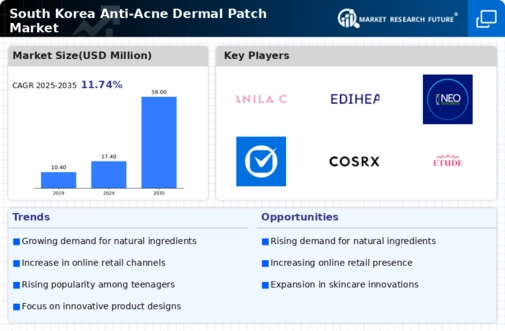Growing Interest in Personalization
The growing interest in personalized skincare solutions is a notable driver for the anti acne-dermal-patch market. Consumers are increasingly seeking products tailored to their specific skin types and concerns. This trend is prompting manufacturers to develop customizable patches that cater to individual needs, such as varying levels of active ingredients or targeted treatment areas. The demand for personalized skincare is expected to rise, with market analysts predicting that personalized products could account for up to 25% of the skincare market by 2027. This shift towards personalization is likely to enhance consumer satisfaction and loyalty, thereby benefiting the anti acne-dermal-patch market.
Increasing Awareness of Skin Health
The growing awareness of skin health among consumers in South Korea is a pivotal driver for the anti acne-dermal-patch market. As individuals become more informed about skincare, they are increasingly seeking effective solutions for acne management. This trend is reflected in the rising sales of anti acne products, with the market projected to reach approximately $150 million by 2026. The emphasis on skin health is further amplified by educational campaigns and dermatological consultations, which encourage the use of targeted treatments like dermal patches. Consumers are now more inclined to invest in products that promise quick and effective results, thereby propelling the demand for innovative solutions in the anti acne-dermal-patch market.
Increased Focus on Youthful Appearance
The increased focus on maintaining a youthful appearance among South Korean consumers is a significant driver for the anti acne-dermal-patch market. As societal standards place a premium on clear and healthy skin, individuals are more motivated to invest in products that promise to enhance their complexion. This cultural emphasis on beauty and youthfulness is reflected in the rising sales of skincare products, with the anti acne-dermal-patch market expected to grow by approximately 10% annually. The desire for effective acne solutions that align with beauty ideals is likely to sustain demand, encouraging innovation and competition within the anti acne-dermal-patch market.
Rising Influence of E-commerce Platforms
The rise of e-commerce platforms significantly impacts the anti acne-dermal-patch market in South Korea. With the increasing penetration of the internet and mobile devices, consumers are turning to online shopping for convenience and variety. E-commerce platforms provide easy access to a wide range of anti acne products, including dermal patches, often at competitive prices. This shift in purchasing behavior is reflected in the growth of online sales, which accounted for approximately 30% of the total skincare market in 2025. The ability to compare products and read reviews online further empowers consumers, making them more likely to try new solutions in the anti acne-dermal-patch market.
Technological Advancements in Product Development
Technological advancements play a crucial role in shaping the anti acne-dermal-patch market. Innovations in materials and formulations have led to the development of more effective and user-friendly patches. For instance, the introduction of hydrocolloid technology has enhanced the efficacy of these patches in absorbing impurities and reducing inflammation. As a result, the market is witnessing a surge in new product launches, with companies investing heavily in research and development. This focus on innovation is expected to drive market growth, with an anticipated CAGR of around 8% over the next five years. The continuous evolution of product offerings is likely to attract a broader consumer base, thereby expanding the anti acne-dermal-patch market.





















Leave a Comment